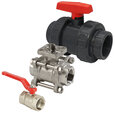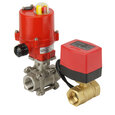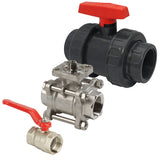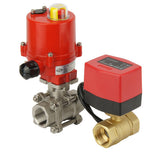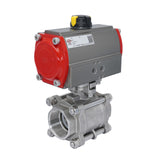Full Port vs Standard Port Ball Valves
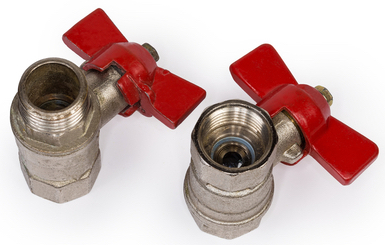
Figure 1: Full port (left) and standard port (right) ball valves
Ball valves can be full port or standard port based on their bore size. Full port ball valves have a bore diameter equal to the pipe size, ensuring minimal flow restriction. In contrast, standard port ball valves have a slightly smaller bore, which can lead to some flow reduction but offers cost and size advantages. Understanding the key differences between full port and standard port ball valves is essential for choosing the correct valve for a system.
Table of contents
- What are full port and standard port ball valves
- When to use full port ball valves
- When to use standard port ball valves
- Full port vs standard port ball valves
- FAQs
View our online selection of ball valves!
What are full port and standard port ball valves
Full port (Full bore) ball valves
Full port ball valves are designed with a straight flow path that matches the diameter of the connected pipe. This ensures minimal resistance to the flow of liquids or gasses. Full port ball valves create very little to no pressure drop when fully open, which is crucial for maintaining the flow rate and reducing the risk of cavitation. They are particularly suitable for applications where maintaining a consistent flow rate is critical and the system is sensitive to pressure changes.
Standard port ball valves
Standard port ball valves typically have an opening one size smaller than the pipe diameter, resulting in a slightly constricted flow path. This design causes a more significant pressure drop even when the valve is fully open, increasing the risk of cavitation in systems with rapid pressure changes. However, standard port ball valves are generally more economical than full port designs for the same pipe size, as their smaller bodies and narrower ports contribute to lower manufacturing costs.
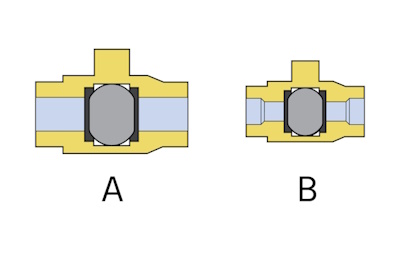
Figure 2: A full port ball valve (A) where the ball's passage diameter matches the pipe diameter, allowing unrestricted flow, and a standard port valve (B) where the passage is smaller than the pipe diameter, creating a flow restriction. Both valves have the same connection size.
When to use full port ball valves
Choose a full port ball valve under the following conditions:
- High flow rate applications
- Low pressure drop requirements
- Handling viscous fluids and solids
- Clean-in-place (CIP) systems
- High temperature and high pressure environments
- Applications requiring unrestricted flow
When to use standard port ball valves
Choose a standard port ball valve in the following conditions:
- Budget is a concern
- Space is limited
- Moderate flow rate requirements
- General-purpose and high turn-over applications, like temporary setups, chemical plants, or plumbing
Full port vs standard port ball valves
Selecting between full port and standard port ball valves depends on the application's requirements.
Table 1: Full port ball valve vs standard port ball valve
| Feature | Full port ball valve | Standard port ball valve |
| Bore size | Equal to the pipe's internal diameter | Smaller than the pipe's internal diameter |
| Flow capacity | Maximum flow capacity with minimal pressure drop | Reduced flow capacity due to smaller bore |
| Pressure drop | Minimal, almost negligible | Higher than full port due to restricted flow path |
| Applications | Ideal for applications requiring unrestricted flow, such as slurry or viscous fluids | Suitable for general applications where slight flow restriction is acceptable |
| Cost | Generally more expensive due to larger size and material use | More economical due to reduced material and size |
| Size and weight | Larger and heavier | Smaller and lighter |
| Installation space | Requires more space for installation | Requires less space, suitable for compact installations |
| Common industries | Oil and gas, chemical processing, water treatment | HVAC, general plumbing, non-critical industrial processes |
| Maintenance | Typically requires less frequent maintenance due to less wear from unrestricted flow | May require more frequent maintenance due to increased wear from flow restriction |
| Valve operation | Provides smooth operation with less turbulence | May experience more turbulence and potential for cavitation |
FAQs
What is the difference between full bore and full port?
"Full bore" and "full port" generally mean the same: the valve's internal diameter matches the pipe's diameter, minimizing flow restriction. Both terms are used interchangeably.
Are other valve types, like gate and globe valves, classified by port size?
Gate and globe valves are typically full ports due to their functions: gate valves open/close with a flat disc, and globe valves regulate flow by changing its path, so varied port sizes aren't needed.
What is the difference between a full port and a standard port ball valve?
In a full port ball valve, the valve ports have the same diameter as the connecting pipes. However, the valve port size is smaller than the pipe diameter in a standard port ball valve.
Why is the standard port more common than the other ball valves?
Standard port ball valves are cost-effective and compact, balancing performance and price for general applications where slight flow restriction is acceptable.




